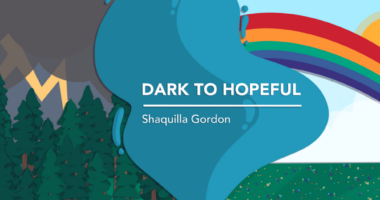My journey from fearing PNH to learning how to fight it
Moving forward after an aplastic anemia and PNH diagnosis

“Why me?” This is the question many patients ask themselves after being diagnosed with an illness.
My first “why me?” moment occurred in 2009 at age 19. Between living in sorority dorms, studying in the library, and eating and socializing in the café, college life filled my days. I had mastered my first year and was back to begin my sophomore year.
Two weeks in, I woke up to my heart beating so fast that, looking in the mirror, I could see my pulse throbbing in my neck. Severe fatigue also slammed me. After two months of being referred to what felt like every doctor in my state, I was finally diagnosed with aplastic anemia. I took a year of medical leave from college to fight the illness and went into remission in 2010.
Fast forward six years, and I was scheduled for a routine six-month checkup. I walked into the hospital thinking it would be a smooth visit and I’d be given the OK for another checkup in six months. To my surprise, I received different news. My doctor said I was out of remission and would need to begin my fight again.
Double the fight
This time around, though, I was also diagnosed with paroxysmal nocturnal hemoglobinuria (PNH). The “why me?” question returned. It felt all too familiar to sit on my bed crying. I didn’t understand how I was going to fight not one, but two blood disorders. My mind was rattled, wondering how I was supposed to begin this journey again.
After moving back home to live with my parents for the second time, I wasn’t hopeful about beginning again. PNH brought on tougher fatigue days that made even lifting myself out of bed a herculean task. I spent countless days in the hospital sitting in a lounge chair receiving blood or platelet transfusions. Discussing treatment options with my doctors was tough, as we had many questions about what my future might look like. What is PNH? How will its symptoms affect my life? How do we tackle two blood disorders?
I soon noticed signs of PNH. Bruises began to show up on my legs, even though I’d never bumped myself there, and I received countless pricks in my arms from blood draws. As I discussed the disorder further with my doctor, he made sure to ask whether I had dark-colored urine. With red blood cells bursting in my body, I did indeed have dark urine full of hemoglobin. Brain fog made it tough to remember conversations five minutes after speaking with someone. I also struggled to concentrate on tasks and get things done day to day.
One important step was deciding on a treatment plan, as I’d need to treat both aplastic anemia and PNH. I had to choose between a bone marrow transplant, a medication that would only treat the PNH, or an immunosuppressant. I chose the latter.
Because I was forced to sit with my symptoms, I took the necessary steps to begin instilling my mind with positive thoughts. I wrote down my goals and dreams and hung the list on my bathroom mirror. Seeing it every day helped me to remember that, despite my illness, I have a purpose in life.
Why me?
Throughout my 14-year health journey, I have faced obstacles that I never thought I could tackle. Through these victories, I’ve decided to share my experience with others so I can help them overcome challenges, too. Finally, I can answer the question, “Why me?”
My hope is to shed light on PNH by telling stories about my journey and my life with blood disorders. I hope my column helps broaden perspectives on PNH and gives other patients ways to cope on their own journeys.
Hello, my name is Brandi Lewis, and I am living with PNH and aplastic anemia. Through my TEDx talk and advocacy work, I’ve been able to shed light on my rare disorders. Please join me on this journey as I tackle what it means to live a full life with PNH.
Note: PNH News is strictly a news and information website about the disease. It does not provide medical advice, diagnosis, or treatment. This content is not intended to be a substitute for professional medical advice, diagnosis, or treatment. Always seek the advice of your physician or other qualified health provider with any questions you may have regarding a medical condition. Never disregard professional medical advice or delay in seeking it because of something you have read on this website. The opinions expressed in this column are not those of PNH News or its parent company, Bionews, and are intended to spark discussion about issues pertaining to paroxysmal nocturnal hemoglobinuria.







